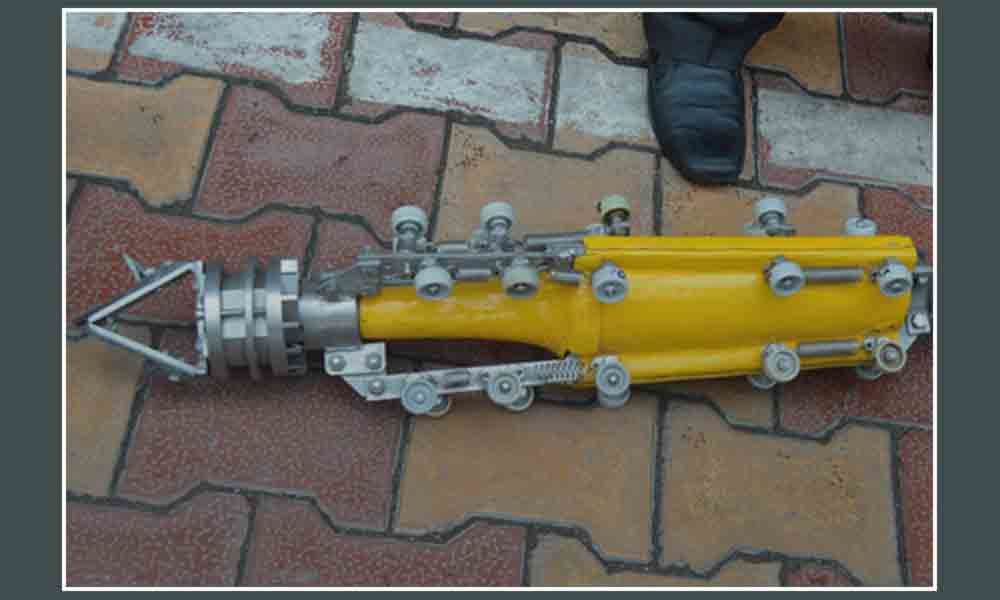Live
- Theft Case of Thumbe Mahalingeshwara Temple
- DIY vs professional car detailing: Pros and Cons
- Wild Elephant Gets Stuck at Rail Track Fence Forest Department Frees Animal
- CERT-In Issues Critical Security Alert for Apple Users: Update Your Devices Now
- Kolar’s Compassionate Leap: Mechanical Elephant Leads Temple Procession
- Centre to unveil startups under new National Quantum Mission guidelines
- Women’s protest rally in Imphal against re-imposition of AFSPA in 6 police station areas
- Greater Nicobar Island project has all environmental clearances: Govt
- Fadnavis leaves for Delhi, expected to meet Amit Shah along with Shinde, Ajit Pawar
- HYDRA-Relocated Residents Struggling with Severe Maintenance Issues at New Dignity Housing Colony
Just In
Khairatabad: Manual scavenging may not end anytime soon

Khairatabad: It is a heinous crime to engage human beings to clean sewers. Civic bodies should make use of jetting and sucking machines to end his inhuman pratice. National Commission for Safai Karamcharis has been advocating machines in place of men to do the menial job.
Manual scavenging was banned 25 years ago with the passing of the Employment of Manual Scavengers and Construction of Dry Latrines (Prohibition) Act, 1993, but it continues to find practitioners. The occupation persists mainly because of the continued presence of insanitary latrines. There are about 2.6 million insanitary latrines (dry toilets) that require cleaning by hand, according to Safai Karmachari Andolan, an NGO that works towards abolishing manual scavenging, and perhaps, the only one in the country, says a report in Down To Earth.
However, this nauseating practice, which provides livelihood for some, may not end anytime soon, as Hyderabad Metropolitan Water Supply and Sewerage Board's (HMWSSB), despite its ambitious plan to put an end to manual scavenging, would have to wait as the proposed robot-operated system is not suitable to city conditions. ML Prasanna Kumar, General Manager, HMWSSB, said the Bengaluru-based suppler has made changes and a demonstration was conducted again. The machine in its present state cannot be used in narrow lanes.
For now, the Water Board has to depend on manual labour. At present, HMWSSB is using 58 air-tech machines to clean the city's 4.7 lakh manholes. A major drawback is that the machines cannot enter narrow lines. Officials have been hopeful of robotic-operated system which would make the process of cleaning the sewage easier.
However, with the introduction of rover cameras and a robotic system, which comprises a robust cutting device and a screen to monitor the operations, HMWSSB plans to minimise manual scavenging and carry out the job with effective use of technology.
The Bengaluru company gave a demonstration on the concept at HMWSSB head office in June 2018 and they sought some changes in the machine. Even after a year, Sewerage Board is still awaiting supply of the system as the company has not completed adapting the device to Hyderabad environs.
HOW IT WORKS
The rover cameras are sent into sewer lines for identifying blockages, including tree roots, debris and sediments. The rover camera can tilt 360-degree and is connected with a 30-metre long wire. Its movement is controlled manually and can be tracked on a monitor. Soon after blockages are identified, Sewer Croc, a robotic device armed with stainless steel cutters, is dropped into the sewer lines.
Mounted on a wheel-base, the sewer croc cuts and chops the accumulated waste in the lines with the blades. It is designed to make use of water supplied from a jetting machine to spin the turbine at high speed and cut the waste.
TRAGIC INCIDENTS
1. Two labourers died after they got asphyxiated inside a manhole near Uppal Cricket Stadium in May 2018
2. Two workers died while cleaning a manhole in Hussainabad of Hyderabad in August 2018
3. Two daily wage labourers fell unconscious while cleaning the manhole in Sanathnagar in December 2017
4. Four contract workers of HMWSSB died after getting trapped in the manhole and inhaling poisonous gases at Ayyappa Society near Madhapur in August 2016
5. Two labourers who were cleaning the manhole died in Hyderabad city in May 2016

© 2024 Hyderabad Media House Limited/The Hans India. All rights reserved. Powered by hocalwire.com










